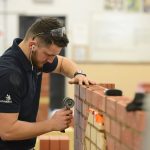 At the back-end of last year I wrote about a fascinating new wearable technology from SmartSite, which is designed to help improve safety levels on construction sites.
At the back-end of last year I wrote about a fascinating new wearable technology from SmartSite, which is designed to help improve safety levels on construction sites.
The company, which is part of the Y Combinator stable, offers hardware that is connected to the cloud to help companies measure what hazardous substances employees are exposed to.
Such exposure is common on building sites, and can lead to conditions such as cancer, dermatitis and a range of respiratory problems. To help reduce this, the SmartSite system monitors particulates in the air, UV rays, and even noise levels on site.
Safe technique
Suffice to say however, that is not the only technology that is helping keep workers free from injury. Researchers from the University of Waterloo explain in a recent paper an AI-based system they’ve developed that helps to reduce wear-and-tear injuries among construction workers.
The system combined motion sensors and AI to examine the techniques used by bricklayers to limit the load on their joints. The researchers hope that their findings can help inform training programs delivered to apprentices to reduce injuries.
“The people in skilled trades learn or acquire a kind of physical wisdom that they can’t even articulate,” the researchers say. “It’s pretty amazing and pretty important.”
The analysis found that the best masons deviate from the ergonomic rules that are usually taught to novices. They nearly all have their own ways of working that is both quick and safe. For instance, they might employ more swinging than lifting of bricks, and nearly all would do as little bending of their backs as possible.
“They’re basically doing the work twice as fast with half the effort – and they’re doing it with higher quality,” the researchers explain. “It’s really intriguing.”
Expert movements
The team plan to follow up their work with another, more detailed study of just how experts move on the job. It’s clear that skilled masons are working in ways that are safer, but it isn’t yet clear how they do that, so the team want to delve into the dynamics more to better understanding things.
Musculoskeletal injuries are a big issue for the industry and cause a sizeable number of apprentices to leave the profession, whilst causing more experienced workers to leave prematurely.
The team are also working on a sensor suit that can be worn during training to give real-time feedback to trainees so that movements can be modified to reduce stress on their bodies.
“There is an unseen problem with craft workers who are just wearing out their bodies,” they say. “It’s not humane and it’s not good for our economy for skilled tradespeople to be done when they’re 50.”